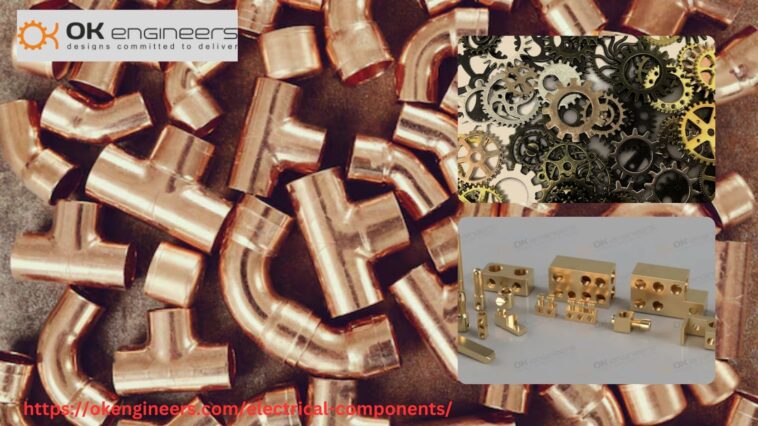Introduction
In the manufacturing world, precision, durability, and reliability are the key attributes that define high-quality components. Brass Turned Parts are among the most widely used components across various industries, from automotive and electronics to plumbing and aerospace. Their versatility and adaptability to different manufacturing processes make them indispensable. This blog explores the significance of Brass Turned Parts, their advantages, manufacturing processes, and the industries that rely on them.
What are Brass Turned Parts?
Brass Turned Parts are precision components manufactured through a process called turning, where brass rods or blanks are shaped into desired forms by a lathe. The turning process ensures that the parts meet strict dimensional requirements, making them highly accurate and reliable. Brass is chosen for its excellent mechanical and electrical properties, which allow the parts to be used in various applications.
Advantages of Using Brass Turned Parts
-
Durability and Strength
One of the most prominent features of Brass Turned Parts is their durability. Brass is a material that can withstand wear and tear, making these components suitable for high-stress environments. Whether used in machinery or electrical equipment, these parts are built to last. -
Corrosion Resistance
Brass is naturally resistant to corrosion, which is particularly beneficial for components used in plumbing, automotive, and marine applications. Brass Turned Parts can endure harsh environments without deteriorating over time, ensuring longevity and performance. -
Electrical Conductivity
For electrical components, the conductivity of brass is a critical feature. Brass Turned Parts ensure efficient energy transfer, which is why they are commonly used in electrical connectors, terminals, and switches. -
Machinability
Brass is a highly machinable material, allowing for the production of intricate designs with tight tolerances. This property makes Brass Turned Parts ideal for custom components that require high precision.
Applications of Brass Turned Parts
The versatility of Brass Turned Parts allows them to be used across a variety of industries:
-
Automotive Industry
In the automotive sector, Brass Turned Parts are used in fuel systems, brakes, and engine components. Their durability and resistance to high temperatures make them perfect for the harsh conditions inside a vehicle. -
Electronics
In electronic applications, Brass Turned Parts are employed as connectors, pins, and terminals. The excellent conductivity of brass ensures that these components perform reliably, even in critical electrical circuits. -
Plumbing
Brass Turned Parts are widely used in plumbing fittings due to their resistance to water corrosion and ability to form leak-free connections. These parts are essential in both residential and commercial plumbing systems. -
Aerospace
The aerospace industry demands high-performance materials that can withstand extreme conditions. Brass Turned Parts are used in various components, from aircraft fittings to fuel systems, due to their strength and reliability. -
Medical Devices
In the medical industry, precision and safety are paramount. Brass Turned Parts are used in equipment such as surgical instruments and diagnostic devices because of their biocompatibility and precision.
The Manufacturing Process of Brass Turned Parts
The production of Brass Turned Parts involves several key steps to ensure that the components meet strict quality standards:
-
Material Selection
The process begins with selecting the appropriate brass alloy based on the application. Different alloys offer unique properties, such as increased strength or improved corrosion resistance. -
Turning Process
In the turning process, a lathe shapes the brass rods or blanks into the required dimensions. This process involves precision cutting and drilling to achieve the desired specifications. -
Secondary Operations
After turning, the parts may undergo additional operations such as threading, knurling, or polishing. These secondary processes enhance the functionality and appearance of the Brass Turned Parts. -
Quality Control
Quality control is an essential step in manufacturing Brass Turned Parts. Each part is inspected to ensure it meets the necessary dimensional and performance requirements.
Future Trends in Brass Turned Parts Manufacturing
As industries continue to evolve, the demand for innovative and high-performance components is growing. Several trends are shaping the future of Brass Turned Parts:
-
Sustainability
With an increasing focus on sustainable manufacturing, companies are looking for ways to reduce waste and improve energy efficiency in the production of Brass Turned Parts. Recyclability and responsible sourcing of materials are becoming key factors. -
Advanced Machining Technologies
The use of advanced machining technologies, such as CNC turning, is revolutionizing the production of Brass Turned Parts. These technologies enable higher precision and faster production times, allowing manufacturers to meet the growing demand for custom components. -
Customization
As industries require more specialized components, the customization of Brass Turned Parts is becoming increasingly popular. Manufacturers are offering tailored solutions that meet the unique needs of specific applications.
Conclusion
In conclusion, Brass Turned Parts are vital components that serve a wide range of industries. Their durability, corrosion resistance, and electrical conductivity make them a preferred choice for various applications, from automotive and electronics to plumbing and aerospace. As manufacturing technologies continue to advance, the production of Brass Turned Parts will become even more efficient and tailored to meet the evolving demands of modern industries. These components will undoubtedly remain essential in the engineering world for years to come.
This post was created with our nice and easy submission form. Create your post!





